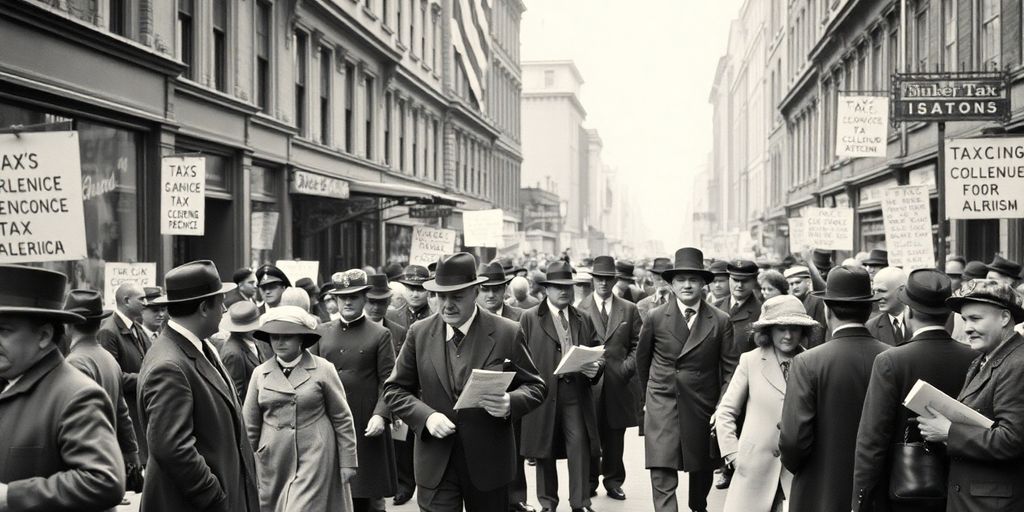Understanding Income Tax Before 1913: A Historical Perspective

Before 1913, the concept of a federal income tax in the United States was pretty much non-existent. The government relied on tariffs and excise taxes to fund its operations. However, as the country grew and faced new challenges like wars and economic changes, the idea of taxing personal income started to gain traction. This article dives into the history of income tax before it became a permanent fixture in American life.
Key Takeaways
- The U.S. didn’t have a federal income tax until 1913.
- Early taxation relied heavily on tariffs and excise taxes.
- The Civil War saw the first temporary income tax in the U.S.
- Public opinion was divided on income tax before it became law.
- The 16th Amendment paved the way for modern income tax.
The Origins Of Income Tax
Early Taxation Practices
Before the United States became a nation, its taxation system was heavily influenced by the British. Colonists paid various taxes, like the infamous tea tax, which contributed to the American Revolution. After gaining independence, the U.S. initially avoided income taxes, relying instead on tariffs and excise taxes. These early levies were on goods like alcohol and tobacco. Direct taxation on individuals was rare and often controversial.
Influence Of The British Empire
The British model of taxation left a lasting imprint on America. Colonists experienced firsthand the impact of taxes imposed by a distant government, which fueled their desire for representation. This historical context shaped American attitudes toward taxation, making citizens wary of federal overreach. The British Empire’s approach to taxation was often seen as heavy-handed, leading to significant resistance and events like the Boston Tea Party.
Colonial Taxation Models
In the colonial period, taxes varied widely among the different colonies. Some colonies imposed property taxes, while others relied on poll taxes or tariffs on imported goods. These models reflected the economic priorities and resources of each colony. As the colonies developed, so did their taxation systems, laying the groundwork for more structured tax policies in the future.
The early taxation systems in America were a patchwork of different approaches, reflecting the diverse economic landscapes and political philosophies of the time. This diversity set the stage for the complex tax system that would evolve in the centuries to come.
The Civil War Era

Introduction Of The First Income Tax
During the Civil War, the U.S. faced massive financial demands. In response, the government introduced the first national income tax in 1861. This tax was a part of the Revenue Act and marked a significant shift from relying solely on tariffs and excise taxes. The tax was relatively modest, starting at 3% on incomes over $800. This was a groundbreaking move, as it laid the foundation for modern federal income tax. The government also established the Office of the Commissioner of Internal Revenue, which would later become the IRS, to oversee tax collection.
Temporary Measures And Their Impact
Initially, the income tax was intended as a temporary measure to fund the war effort. However, its effects were profound. The introduction of this tax not only helped finance the Union’s war efforts but also set a precedent for federal taxation power. After the war, the tax was repealed in 1872, but the idea of federal income tax had taken root. This period also saw the implementation of excise taxes on goods like tobacco and alcohol, which continued to be a significant revenue source.
Post-War Tax Reforms
Following the Civil War, the U.S. grappled with how to manage taxation. The temporary income tax was abolished, but the debate over federal taxation continued. In the late 19th century, attempts were made to reintroduce an income tax, reflecting ongoing tensions between different economic classes. The Supreme Court’s decision in Pollock v. Farmers’ Loan & Trust Co. in 1895 struck down a federal income tax law, citing it as unconstitutional, which intensified calls for reform. This era set the stage for the eventual ratification of the 16th Amendment, permanently establishing the federal income tax system in 1913.
The Gilded Age And Taxation

Economic Growth And Wealth Disparity
The Gilded Age, stretching from the 1870s to the early 1900s, was a time of extraordinary economic expansion in the United States. Railroads stretched across the country, factories churned out goods, and cities expanded rapidly. However, this growth wasn’t evenly distributed. The gap between the wealthy and the poor widened significantly. Many industrialists amassed enormous fortunes, while the average worker saw only modest gains in wages. This disparity sparked debates about fairness in the economic system and whether the wealthy were paying their fair share in taxes.
Public Sentiment On Taxation
The public’s view on taxation during the Gilded Age was mixed. On one hand, there was a growing belief that the rich should contribute more to society, especially as their fortunes grew. On the other hand, many feared that higher taxes could stifle the economic growth that was benefiting the country. This tension played out in political arenas, with some advocating for more progressive tax policies while others pushed for minimal government interference in the economy.
State-Level Tax Initiatives
During this era, states began experimenting with their own tax policies to address local needs. Some states introduced income taxes, while others focused on property taxes or sales taxes. These initiatives reflected the diverse economic landscapes across the country and the varying priorities of state governments. As states grappled with their own fiscal challenges, they laid the groundwork for future national tax policies that would emerge in the 20th century.
The Gilded Age was a period of great economic promise but also significant social challenges. As wealth accumulated at the top, the call for fair taxation became a rallying cry for many seeking a more equitable society.
The Progressive Movement
Calls For Tax Reform
In the late 19th and early 20th centuries, the United States saw a surge in demands for tax reform. The industrial boom had widened the gap between the wealthy and the working class, leading to public dissatisfaction with the existing tax system. People were frustrated with how the rich seemed to get away with paying little to no taxes while the average worker bore the brunt of the tax burden. This growing discontentment fueled the Progressive Movement, which aimed to address social and economic inequalities through legislative change.
The Role Of Activist Groups
Activist groups played a pivotal role in pushing for tax reforms during the Progressive Era. Organizations like the National Tax Association and other civic groups were instrumental in educating the public and lobbying for a fairer tax system. They argued that a progressive tax system, where tax rates increased with income, would be more equitable. These groups organized rallies, published pamphlets, and worked tirelessly to sway public opinion and influence policymakers.
Legislative Changes In Tax Policy
The efforts of the Progressive Movement eventually led to significant legislative changes. One of the most notable outcomes was the introduction of the 16th Amendment, which allowed the federal government to levy an income tax without apportioning it among the states or basing it on the U.S. Census. This amendment laid the groundwork for a progressive tax system that aimed to redistribute wealth more fairly across different income levels. The passage of the Revenue Act of 1913 further solidified these changes, marking a turning point in American tax policy.
The Road To The 16th Amendment
Political Climate Leading To Change
By the early 1900s, there was a growing dissatisfaction with the tax system in the United States. Many people felt that the rich were not paying their fair share, while the poor were overburdened. President William Howard Taft recognized this inequality and advocated for change. In 1909, during the debate over the Payne-Aldrich tariff, Taft proposed a constitutional amendment that would allow the federal government to impose an income tax without apportionment among the states. This move was partly influenced by the Supreme Court’s Pollock decision, which had previously struck down an income tax law.
Key Figures In The Movement
President Taft played a pivotal role in pushing for the Sixteenth Amendment. His efforts were supported by various progressive groups and politicians who saw the need for a more equitable tax system. These advocates argued that a federal income tax was essential to ensure that wealthier individuals contributed more to the national revenue. Taft’s administration worked tirelessly to gain the necessary support in Congress and among the states for ratification.
Public Opinion And The Amendment Process
Public opinion was mixed during this period. Many supported the idea of taxing the wealthy more heavily, but there were also concerns about the federal government’s increased power. Despite these concerns, the Sixteenth Amendment was ratified on February 3, 1913, after Delaware became the 36th state to approve it. This landmark amendment fundamentally changed how the federal government generated revenue, moving away from reliance on tariffs and excise taxes. The first 1040 form appeared in 1914, marking the beginning of a new era in American taxation.
Comparative Tax Systems
Income Tax In Other Countries
Before the 16th Amendment, the United States was navigating a tax landscape that was vastly different from many other countries. In Europe, for instance, income taxes had already been established in several countries by the late 19th century. The United Kingdom introduced its income tax in 1799, primarily to fund the Napoleonic Wars. Similarly, Prussia implemented an income tax in 1891, setting a precedent for other German states to follow. These early adopters of income tax systems were often motivated by the need to fund military endeavors and public services.
Lessons From International Models
Looking at these international models, the U.S. could see both pitfalls and successes. European countries, for example, demonstrated how a structured income tax could provide a steady revenue stream for the government. However, they also showed that without careful management, such taxes could lead to public discontent. The British experience, where income tax was initially a temporary measure, underscores the importance of clear communication and gradual implementation to gain public acceptance.
Impact On American Tax Policy
The lessons learned from abroad significantly influenced American tax policy. As the U.S. grappled with its own fiscal challenges, including funding wars and expanding public infrastructure, the idea of a federal income tax became increasingly appealing. The comparative analysis of tax systems helped shape America’s approach, ensuring that when the income tax was finally institutionalized with the 16th Amendment, it was designed to be both fair and effective. This global perspective was crucial in crafting a tax system that aimed to balance revenue generation with public approval.
Understanding how other nations approached income taxation before 1913 provides a fascinating glimpse into the global economic strategies of the time. It highlights the universal challenges governments face in funding their operations and the innovative solutions they employ to meet these needs.
Cultural Attitudes Towards Taxation
Taxation And American Identity
Taxation has always been a hot topic in the U.S., shaping much of the nation’s identity. Early American resistance to British taxes, like the infamous Boston Tea Party, set the stage for a country that values its financial independence. The idea of "no taxation without representation" became a rallying cry for freedom and self-governance. Over time, taxes have been seen as both a necessary evil and a civic duty. Many Americans view taxes as a way to contribute to the common good, funding public services and infrastructure. Yet, there’s also a deep-seated wariness about how tax dollars are used, reflecting a broader skepticism of government power.
Religious Perspectives On Taxation
Religious views on taxation are as varied as the faiths in America. Some religious teachings emphasize the importance of supporting community welfare through taxes, aligning with the idea of charity and helping those in need. For instance, many Christian denominations see paying taxes as a moral obligation, a way to "render unto Caesar what is Caesar’s." On the other hand, some religious groups argue for minimal taxation, stressing individual responsibility over government intervention. This diversity in views highlights the complex relationship between personal beliefs and public policy.
Literature And Taxation
Throughout American literature, taxes have appeared as symbols of oppression, duty, and social responsibility. Writers like Mark Twain and Herman Melville often critiqued the tax system, using satire to highlight its flaws. In many stories, taxes serve as a backdrop for exploring themes of justice and fairness, questioning who benefits from tax policies. Novels and essays have long reflected the tension between individual freedom and societal obligations, using taxation as a lens to examine these conflicts.
The cultural narrative around taxes is one of balance—between personal freedom and collective responsibility, between skepticism and trust in governance. As America evolved, so did its views on taxation, shaping how citizens interact with their government and each other.
The acceptance of federal income tax, marked by the 16th Amendment, reflects a shift in how Americans perceive the role of government in managing economic resources. This change underscores a broader acceptance of taxes as a means to fund essential services and maintain social order.
Conclusion
Before 1913, the idea of a federal income tax in the U.S. was a bit of a rollercoaster. It was tried, tossed out, and tried again. The Civil War brought the first real attempt, but it didn’t stick around. Then, in 1913, the 16th Amendment made it official, and we’ve been dealing with it ever since. Back then, taxes were mostly about tariffs and sales. But as the country grew, so did the need for a more structured tax system. It’s wild to think about how different things were back then, with taxes being a hot topic even without the IRS breathing down your neck every April. Understanding this history gives us a peek into how our current tax system came to be and why it sometimes feels like a tangled web. It’s a reminder of how much things can change and yet, somehow, stay the same.
Frequently Asked Questions
What was the first income tax in the United States?
The first income tax in the United States was introduced during the Civil War in 1861 to help fund the war effort. It was later repealed in 1872.
Why was the 16th Amendment important?
The 16th Amendment, ratified in 1913, allowed the federal government to collect income taxes without apportioning them among the states based on population.
How did people feel about taxes before 1913?
Before 1913, many people were against income taxes. They preferred taxes on goods and tariffs to fund the government.
What kinds of taxes existed before the federal income tax?
Before the federal income tax, there were taxes like excise taxes on items such as alcohol and tobacco, as well as tariffs on imported goods.
How did the Civil War affect taxes?
The Civil War led to the first national income tax in the United States as a way to raise money for the Union’s war efforts.
What is the difference between excise taxes and income taxes?
Excise taxes are levied on specific goods, like alcohol and tobacco, while income taxes are based on the money people earn.







Responses